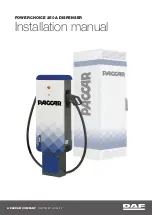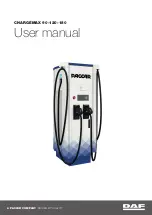
INTRODUCTION
Congratulations to your new professional MULTI XS 7000 Switch
Mode Charger with Pulse Maintenance, Boost and Float.
MULTI XS 7000 is a member of a family of professional chargers from
CTEK Sweden AB. It represents the state-of-the-art of today’s technol-
ogy for battery charging. A MULTI XS 7000 will prolong the lifetime
of your battery.
Please read this manual carefully and follow the
instructions.
SAFETY
•
The charger is designed for lead-acid batteries 14-225 Ah. Do not
use for any other purposes.
•
Always use safety glasses and turn your face away from the battery
when making or breaking connections!
•
A battery being charged could emit explosive gasses. Prevent
fl ames and sparks close to the battery.
•
Always provide for proper ventilation during charging.
•
Avoid covering the charger.
•
Battery acid is corrosive. Rinse immediately with water if acid comes
into contact with skin or eyes. Seek medical advice.
•
Don’t charge a frozen battery.
•
Never operate a damaged charger.
•
Never place the charger on top of the battery when charging.
•
Always check that the charger has gone over to maintenance
charging mode before leaving the charger unattended and connected
for long periods. If the charger had not gone over to maintenance
charging with 72 hours, this is an indication of an error. In this case the
charger must be disconnected manually.
•
All batteries fail sooner or later. A battery that fails during charging
is normally taken care of by the chargers advanced control, but some
rare errors in the battery could still exist. Don’t leave any.
battery unattended for a longer period of time.
BATTERY TYPES AND SETTINGS
MULTI XS 7000 can easily be set for different types of batteries or
conditions. The following recommendations should, however, only be
seen as guidelines. Please consult the battery manufacturer for further
instructions.
Settings are made by pressing the ”MODE-button” and stepping
forward one press at a time until the required mode is reached, the
button is then released. After about 2 seconds the charger activates
the selected mode. The selected mode is saved in a memory in the
charger and remains there even if the charger is switched off.
Mode 14.4 V -
Normal setting for wet batteries, MF and for most Gel
batteries.
Mode 14.7 V -
This setting is recommended for a battery at
temperatures < 5 degrees C. It is also recommended for many AGM
batteries like Optima, Maxxima and Odysseys. Consult your battery
manufacturer when in doubt.
Mode 13.6 V / Supply -
The charger is operating at a constant volt-
age of 13.6 V. This is the maintenance mode for applications where
maximum capacity from the battery is important, like fl oor sweepers
and golf carts. The MULTI XS 7000 could also be used as a power
supply without a battery attached in this setting. Note that the Spark
Free function is suppressed in this mode.
Mode 16 V / 1.5 A / 4 h -
This mode is used to recover deep dis-
charged batteries where you could expect a stratifi ed acid (high acid
weight in the bottom, low on top). Note that the battery has to be fully
charged fi rst. Use this mode with care, because the high voltage will
cause some water loss. 16 V is normally no problem for electronics,
but consult your supplier when in doubt. Life of light bulbs will reduced
at higher voltage. Try to avoid using 12 V light from the battery during
this phase. Maximum effect and minimum risk for electronics is
achieved by charging a disconnected battery.
CHARGING
Charging batteries in a vehicle:
1.
The power cord should be disconnected before connection or
disconnection of the battery leads.
2.
Identify the pole that is grounded. Ground is normally connected to
the negative terminal.
3.
Charging of negative grounded battery:
Charging of negative grounded battery: Connect the red wire to the
positive pole of the battery and the black cable to ground. Be aware
that the connection isn’t made to a metal fuel pipe.
4.
Charging of positive grounded battery:
Charging of positive grounded battery: Connect the black wire to
the negative pole of the battery and the red cable to ground. Be aware
that the connection isn't made to a metal fuel pipe.
Charging of a battery not connected to a vehicle:
1.
The power cord should be disconnected before connection or
disconnection of the battery leads.
2.
Connect the red wire to the positive pole of the battery and the
black cable to the negative pole.
The red alarm indication light (0) will indicate a battery, which is
connected to reverse polarity (will not work in Supply Mode). The
red alarm indication light (0) will also indicate if the charge cycle is
activated without any battery connected to the battery leads.
Start charging
1.
Connect the power cord to the power outlet. The charger indicates
STANDBY, yellow indication light (A).
2.
Set the proper charging mode for the battery by pushing the Mode
Selector Button (see Battery Types and Settings).
3.
The lamp for Deep Discharged battery (1) will indicate if the battery
has been discharged down to below 10.5 V. A boost phase could be
needed after the completed charge cycle.
4.
Normal charging settings (14.4 V or 14.7 V) will be indicated by the
lamps for Deep Discharged (1), Bulk Charge (2), Absorption Charge
(3) or Maintenance Charge (4). The lamp for maintenance means
that the battery is fully charged. The charge will restart if the voltage
drops. The charger can by connected for months. The Supply or Boost
settings are indicated by the lamps for those settings.
5.
The red alarm indication light (0) will indicate a battery, which is
connected to reverse polarity (will not work in Supply Mode). The
red alarm indication light (0) will also indicate if the charge cycle is
activated without any battery connected to the battery leads.
6.
If nothing happens: A bad connection of the battery to ground will
be indicated by a no light from the charging lamps or that the indicator
lamp is still in the Standby-mode (lamp A). A bad battery will also be
indicated in the same way. Don’t forget to check the wall outlet. If you
experience problems: start with the sensitive connection between the
battery clamps and the charger.
7.
A fl ickering between the lamps for charging and fully charged could
be caused by several reasons.
a.
A lost connection. This is most likely in the cabling but could also be
internal. Put the charger in STANDBY and try to restart.
b.
A lightly sulphated battery which has problems to be initiated. The
fl ickering will end within 60 minutes if the battery could be recovered.
The battery cannot be recharged if the fl ickering continues.
c.
A battery with high self discharge could be seen when the Fully
charged lamp is on for 10 seconds and more, combined with a short
Charge indication. Such a battery is at the end of its life and needs to
be replaced.
8.
The charging could be interrupted at any time by disconnecting
the supply cord or by setting the charger in Stand by. Removing the
ground lead fi rst when disconnecting the battery leads from a battery
in a vehicle.
Switch Mode
BATTERY CHARGER
For lead-acid batteries 14-225Ah
MULTI XS 7000
User’s Manual and a guide
to professional battery charging.
For Starter/Deep Cycle batteries.
UK




















